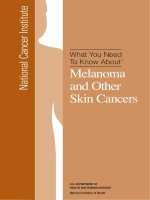Tài liệu What You Need To Know About - Melanoma and Other Skin Cancers doc
Bạn đang xem bản rút gọn của tài liệu. Xem và tải ngay bản đầy đủ của tài liệu tại đây (1.91 MB, 59 trang )
National Cancer Institute
What You Need
To Know About
TM
Melanoma
and Other
Skin Cancers
U.S. DEPARTMENT OF
HEALTH AND HUMAN SERVICES
National Institutes of Health
National Cancer Institute Services
This is only one of many free booklets for
people with cancer.
You may want more information for yourself,
your family, and your doctor.
NCI offers comprehensive research-based
information for patients and their families, health
professionals, cancer researchers, advocates, and
the public.
• Call NCI’s Cancer Information Service at
1–800–4–CANCER (1–800– 422–6237)
• Visit us at or
/>• Chat using LiveHelp, NCI’s instant
messaging service, at />livehelp
• E-mail us at
• Order publications at />publications or by calling 1–800– 4–CANCER
• Get help with quitting smoking at
1–877–44U–QUIT (1–877–448–7848)
U.S. DEPARTMENT OF
HEALTH AND HUMAN SERVICES
National Institutes of Health
National Cancer Institute
Contents
About This Booklet 1
The Skin 3
Cancer Cells 5
Types of Skin Cancer 6
Risk Factors 7
Symptoms 12
Diagnosis 16
Staging 17
Treatment 21
Second Opinion 32
Taking Part in Cancer Research 34
Follow-up Care 35
Prevention 36
How To Check Your Skin 37
Sources of Support 38
Dictionary 40
National Cancer Institute Publications 53
About This Booklet
This National Cancer Institute (NCI) booklet is for
people diagnosed with the most common types of skin
cancer:*
• Melanoma
• Basal cell skin cancer
• Squamous cell skin cancer
Skin cancer is the most common type of cancer in
the United States. Each year, more than 68,000
Americans are diagnosed with melanoma, and another
48,000 are diagnosed with an early form of the disease
that involves only the top layer of skin. Also, more
than 2 million people are treated for basal cell or
squamous cell skin cancer each year. Basal cell skin
cancer is several times more common than squamous
cell skin cancer.
Learning about medical care for skin cancer can
help you take an active part in making choices about
your care. This booklet tells about:
• Diagnosis and staging
• Treatment
• Follow-up care
• How to prevent another skin cancer from forming
• How to do a skin self-exam
This booklet has lists of questions that you may
want to ask your doctor. Many people find it helpful to
take a list of questions to a doctor visit. To help
remember what your doctor says, you can take notes.
1
*Words in italics are in the Dictionary on page 40. The Dictionary
explains these terms. It also shows how to pronounce them.
You may also want to have a family member or friend
go with you when you talk with the doctor—to take
notes, ask questions, or just listen.
For the latest information about skin cancer, please
visit our Web site at />cancertopics/types/skin. For information about
melanoma, go to />cancertopics/types/melanoma.
Also, NCI’s Cancer Information Service can answer
your questions about skin cancer. We can also send you
NCI booklets and fact sheets. Call 1–800–4–CANCER
(1–800–422–6237) or chat with us online using
LiveHelp, NCI’s instant messaging service at
/>This booklet does not describe rare types of skin
cancer, such as Merkel cell carcinoma. Also, this
booklet does not discuss melanoma that begins in the
eye, the digestive tract, or other areas of the body.
NCI’s Cancer Information Service can provide
information about rare skin cancers and melanoma that
begins in areas other than the skin.
2
The Skin
Your skin protects your body from heat, injury, and
infection. It also protects your body from damage
caused by ultraviolet (UV) radiation (such as from the
sun or sunlamps).
Your skin stores water and fat. It helps control body
heat. Also, your skin makes vitamin D.
The picture on the next page shows the two main
layers of the skin:
• Epidermis: The epidermis is the top layer of your
skin. It’s mostly made of flat cells called squamous
cells.
Below the squamous cells deeper in the epidermis
are round cells called basal cells.
Cells called melanocytes are scattered among the
basal cells. They are in the deepest part of the
epidermis. Melanocytes make the pigment (color)
found in skin. When skin is exposed to UV
radiation, melanocytes make more pigment, causing
the skin to darken, or tan.
• Dermis: The dermis is the layer under the epidermis.
The dermis contains many types of cells and
structures, such as blood vessels, lymph vessels, and
glands. Some of these glands make sweat, which
helps cool your body. Other glands make sebum.
Sebum is an oily substance that helps keep your skin
from drying out. Sweat and sebum reach the surface
of your skin through tiny openings called pores.
3
4
Hair shaft
Oil gland
Epidermis
Dermis
Lymph vessel
Sweat gland
Fatty tissue
This picture shows the layers of the skin—the
epidermis and dermis. At the top, the close-up shows
a squamous cell, basal cell, and melanocyte.
Basal cell
Melanocyte
Squamous
cells
Epidermis
Dermis
Blood vessels
© 2010 Terese Winslow
U.S. Govt. has certain rights
Cancer Cells
Cancer begins in cells, the building blocks that make
up tissues. Tissues make up the skin and other organs
of the body.
Normal cells grow and divide to form new cells as
the body needs them. When normal cells grow old or
get damaged, they usually die, and new cells take their
place.
But sometimes this process goes wrong. New cells
form when the body doesn’t need them, and old or
damaged cells don’t die as they should. The buildup of
extra cells often forms a mass of tissue called a growth
or tumor.
Growths on the skin can be benign (not cancer) or
malignant (cancer). Benign growths are not as harmful
as malignant growths.
• Benign growths (such as moles):
—Are rarely a threat to life
—Generally can be removed and usually don’t grow
back
—Don’t invade the tissues around them
—Don’t spread to other parts of the body
• Malignant growths (such as melanoma, basal cell
cancer, or squamous cell cancer):
—May be a threat to life
—Often can be removed but sometimes grow back
—May invade and damage nearby organs and
tissues
—May spread to other parts of the body
5
Types of Skin Cancer
Skin cancers are named for the type of cells that
become malignant (cancer). The three most common
types are:
• Melanoma: Melanoma begins in melanocytes
(pigment cells). Most melanocytes are in the skin.
See the picture on page 4 of a melanocyte and other
skin cells.
Melanoma can occur on any skin surface. In men,
it’s often found on the skin on the head, on the neck,
or between the shoulders and the hips. In women,
it’s often found on the skin on the lower legs or
between the shoulders and the hips.
Melanoma is rare in people with dark skin. When it
does develop in people with dark skin, it’s usually
found under the fingernails, under the toenails, on
the palms of the hands, or on the soles of the feet.
• Basal cell skin cancer: Basal cell skin cancer
begins in the basal cell layer of the skin. It usually
occurs in places that have been in the sun. For
example, the face is the most common place to find
basal cell skin cancer.
In people with fair skin, basal cell skin cancer is the
most common type of skin cancer.
• Squamous cell skin cancer: Squamous cell skin
cancer begins in squamous cells. In people with
dark skin, squamous cell skin cancer is the most
common type of skin cancer, and it’s usually found
in places that are not in the sun, such as the legs or
feet.
However, in people with fair skin, squamous cell
skin cancer usually occurs on parts of the skin that
have been in the sun, such as the head, face, ears,
and neck.
6
Unlike moles, skin cancer can invade the normal
tissue nearby. Also, skin cancer can spread throughout
the body. Melanoma is more likely than other skin
cancers to spread to other parts of the body. Squamous
cell skin cancer sometimes spreads to other parts of the
body, but basal cell skin cancer rarely does.
When skin cancer cells do spread, they break away
from the original growth and enter blood vessels or
lymph vessels. The cancer cells may be found in
nearby lymph nodes. The cancer cells can also spread
to other tissues and attach there to form new tumors
that may damage those tissues.
The spread of cancer is called metastasis. See the
Staging section on page 17 for information about skin
cancer that has spread.
Risk Factors
When you’re told that you have skin cancer, it’s
natural to wonder what may have caused the disease.
The main risk factor for skin cancer is exposure to
sunlight (UV radiation), but there are also other risk
factors. A risk factor is something that may increase the
chance of getting a disease.
People with certain risk factors are more likely than
others to develop skin cancer. Some risk factors vary
for the different types of skin cancer.
7
Risks for Any Type of Skin Cancer
Studies have shown that the following are risk
factors for the three most common types of skin
cancer:
• Sunlight: Sunlight is a source of UV radiation. It’s
the most important risk factor for any type of skin
cancer. The sun’s rays cause skin damage that can
lead to cancer.
—Severe, blistering sunburns: People who have
had at least one severe, blistering sunburn are at
increased risk of skin cancer. Although people
who burn easily are more likely to have had
sunburns as a child, sunburns during adulthood
also increase the risk of skin cancer.
—Lifetime sun exposure: The total amount of sun
exposure over a lifetime is a risk factor for skin
cancer.
—Tanning: Although a tan slightly lowers the risk
of sunburn, even people who tan well without
sunburning have a higher risk of skin cancer
because of more lifetime sun exposure.
Sunlight can be reflected by sand, water, snow, ice,
and pavement. The sun’s rays can get through
clouds, windshields, windows, and light clothing.
In the United States, skin cancer is more common
where the sun is strong. For example, more people
in Texas than Minnesota get skin cancer. Also, the
sun is stronger at higher elevations, such as in the
mountains.
Doctors encourage people to limit their exposure to
sunlight. See the Prevention section on page 36 for
ways to protect your skin from the sun.
8
• Sunlamps and tanning booths: Artificial sources
of UV radiation, such as sunlamps and tanning
booths, can cause skin damage and skin cancer.
Health care providers strongly encourage people,
especially young people, to avoid using sunlamps
and tanning booths. The risk of skin cancer is
greatly increased by using sunlamps and tanning
booths before age 30.
• Personal history: People who have had melanoma
have an increased risk of developing other
melanomas. Also, people who have had basal cell or
squamous cell skin cancer have an increased risk of
developing another skin cancer of any type.
• Family history: Melanoma sometimes runs in
families. Having two or more close relatives
(mother, father, sister, brother, or child) who have
had this disease is a risk factor for developing
melanoma. Other types of skin cancer also
sometimes run in families. Rarely, members of a
family will have an inherited disorder, such as
xeroderma pigmentosum or nevoid basal cell
carcinoma syndrome, that makes the skin more
sensitive to the sun and increases the risk of skin
cancer.
• Skin that burns easily: Having fair (pale) skin that
burns in the sun easily, blue or gray eyes, red or
blond hair, or many freckles increases the risk of
skin cancer.
• Certain medical conditions or medicines: Medical
conditions or medicines (such as some antibiotics,
hormones, or antidepressants) that make your skin
more sensitive to the sun increase the risk of skin
cancer. Also, medical conditions or medicines that
suppress the immune system increase the risk of skin
cancer.
9
Other Risk Factors for Melanoma
The following risk factors increase the risk of
melanoma:
• Dysplastic nevus: A dysplastic nevus is a type of
mole that looks different from a common mole. A
dysplastic nevus may be bigger than a common
mole, and its color, surface, and border may be
different. It’s usually wider than a pea and may be
longer than a peanut. A dysplastic nevus can have a
mixture of several colors, from pink to dark brown.
Usually, it’s flat with a smooth, slightly scaly or
pebbly surface, and it has an irregular edge that may
fade into the surrounding skin.
A dysplastic nevus is more likely than a common
mole to turn into cancer. However, most do not
change into melanoma. A doctor will remove a
dysplastic nevus if it looks like it might have
changed into melanoma.
• More than 50 common moles: Usually, a common
mole is smaller than a pea, has an even color (pink,
tan, or brown), and is round or oval with a smooth
surface. Having many common moles increases the
risk of developing melanoma.
10
Other Risk Factors for Both Basal Cell and
Squamous Cell Skin Cancers
The following risk factors increase the risk of basal
cell and squamous cell skin cancers:
• Old scars, burns, ulcers, or areas of inflammation
on the skin
• Exposure to arsenic at work
• Radiation therapy
Other Risk Factors for Squamous Cell Cancer
The risk of squamous cell skin cancer is increased
by the following:
• Actinic keratosis: Actinic keratosis is a type of flat,
scaly growth on the skin. It is most often found on
areas exposed to the sun, especially the face and the
backs of the hands. The growth may appear as a
rough red or brown patch on the skin. It may also
appear as cracking or peeling of the lower lip that
does not heal. Without treatment, this scaly growth
may turn into squamous cell skin cancer.
• HPV (human papillomavirus): Certain types of
HPV can infect the skin and may increase the risk of
squamous cell skin cancer. These HPVs are different
from the HPV types that cause cervical cancer and
other cancers in the female and male genital areas.
11
Symptoms
Symptoms of Melanoma
Often the first sign of melanoma is a change in the
shape, color, size, or feel of an existing mole.
Melanoma may also appear as a new mole. Thinking
of “ABCDE” can help you remember what to look for:
• Asymmetry: The shape of one half does not match
the other half.
• Border that is irregular: The edges are often
ragged, notched, or blurred in outline. The pigment
may spread into the surrounding skin.
• Color that is uneven: Shades of black, brown, and
tan may be present. Areas of white, gray, red, pink,
or blue may also be seen.
• Diameter: There is a change in size, usually an
increase. Melanomas can be tiny, but most are larger
than the size of a pea (larger than 6 millimeters or
about 1/4 inch).
• Evolving: The mole has changed over the past few
weeks or months.
Melanomas can vary greatly in how they look.
Many show all of the ABCDE features. However,
some may show changes or abnormal areas in only one
or two of the ABCDE features.
In more advanced melanoma, the texture of the
mole may change. The skin on the surface may break
down and look scraped. It may become hard or lumpy.
The surface may ooze or bleed. Sometimes the
melanoma is itchy, tender, or painful.
12
13
This photo shows a dysplastic nevus
with an arrow pointing to a new black
bump that was not there 18 months
earlier. The black bump is a melanoma
that is about 3 millimeters.
This photo shows an asymmetric
melanoma with irregular and scalloped
borders. The color varies from gray to
brown to black. The melanoma is about
1.2 centimeters.
14
• A lump that is small, smooth, shiny, pale, or waxy
• A lump that is firm and red
Symptoms of Basal Cell and Squamous Cell
Skin Cancers
A change on the skin is the most common sign of
skin cancer. This may be a new growth, a sore that
doesn’t heal, or a change in an old growth. Not all skin
cancers look the same. Usually, skin cancer is not
painful.
Common symptoms of basal cell or squamous cell
skin cancer include:
15
• A flat red spot that is rough, dry, or scaly and may
become itchy or tender
• A red or brown patch that is rough and scaly
• A sore or lump that bleeds or develops a crust or a
scab
16
Diagnosis
If you have a change on your skin, your doctor must
find out whether or not the problem is from cancer.
You may need to see a dermatologist, a doctor who has
special training in the diagnosis and treatment of skin
problems.
Your doctor will check the skin all over your body
to see if other unusual growths are present.
If your doctor suspects that a spot on the skin is
cancer, you may need a biopsy. For a biopsy, your
doctor may remove all or part of the skin that does not
look normal. The sample goes to a lab. A pathologist
checks the sample under a microscope. Sometimes it’s
helpful for more than one pathologist to check the
tissue for cancer cells.
You may have the biopsy in a doctor’s office or as
an outpatient in a clinic or hospital. You’ll probably
have local anesthesia.
There are four common types of skin biopsies:
• Shave biopsy: The doctor uses a thin, sharp blade to
shave off the abnormal growth.
• Punch biopsy: The doctor uses a sharp, hollow tool
to remove a circle of tissue from the abnormal area.
• Incisional biopsy: The doctor uses a scalpel to
remove part of the growth.
• Excisional biopsy: The doctor uses a scalpel to
remove the entire growth and some tissue around it.
This type of biopsy is most commonly used for
growths that appear to be melanoma.
17
You may want to ask your doctor these
questions before having a biopsy:
• Which type of biopsy do you suggest for me?
• How will the biopsy be done?
• Will I have to go to the hospital?
• How long will it take? Will I be awake? Will it
hurt?
• Will the entire growth be removed?
• Are there any risks? What are the chances of
infection or bleeding after the biopsy?
• Will there be a scar? If so, what will it look
like?
• How soon will I know the results?
• If I do have cancer, who will talk with me
about treatment?
Staging
If the biopsy shows that you have skin cancer, your
doctor needs to learn the stage (extent) of the disease to
help you choose the best treatment.
The stage is based on:
• The size (width) of the growth
• How deeply it has grown beneath the top layer of
skin
• Whether cancer cells have spread to nearby lymph
nodes or to other parts of the body
18
When skin cancer spreads from its original place to
another part of the body, the new tumor has the same
kind of abnormal cells and the same name as the
primary (original) tumor. For example, if skin cancer
spreads to the lung, the cancer cells in the lung are
actually skin cancer cells. The disease is metastatic
skin cancer, not lung cancer. For that reason, it’s
treated as skin cancer, not as lung cancer. Doctors
sometimes call the new tumor “distant” disease.
Blood tests and an imaging test such as a chest
x-ray, a CT scan, an MRI, or a PET scan may be used
to check for the spread of skin cancer. For example, if
a melanoma growth is thick, your doctor may order
blood tests and an imaging test.
For squamous cell skin cancer or melanoma, the
doctor will also check the lymph nodes near the cancer
on the skin. If one or more lymph nodes near the skin
cancer are enlarged (or if the lymph node looks
enlarged on an imaging test), your doctor may use a
thin needle to remove a sample of cells from the lymph
node (fine-needle aspiration biopsy). A pathologist will
check the sample for cancer cells.
Even if the nearby lymph nodes are not enlarged,
the nodes may contain cancer cells. The stage is
sometimes not known until after surgery to remove the
growth and one or more nearby lymph nodes. For thick
melanoma, surgeons may use a method called sentinel
lymph node biopsy to remove the lymph node most
likely to have cancer cells. Cancer cells may appear
first in the sentinel node before spreading to other
lymph nodes and other places in the body.
19
Stages of Melanoma
These are the stages of melanoma:
• Stage 0: The melanoma involves only the top layer
of skin. It is called melanoma in situ.
• Stage I: The tumor is no more than 1 millimeter
thick (about the width of the tip of a sharpened
pencil.) The surface may appear broken down. Or,
the tumor is between 1 and 2 millimeters thick, and
the surface is not broken down.
• Stage II: The tumor is between 1 and 2 millimeters
thick, and the surface appears broken down. Or, the
thickness of the tumor is more than 2 millimeters,
and the surface may appear broken down.
• Stage III: The melanoma cells have spread to at
least one nearby lymph node. Or, the melanoma
cells have spread from the original tumor to tissues
nearby.
• Stage IV: Cancer cells have spread to the lung or
other organs, skin areas, or lymph nodes far away
from the original growth. Melanoma commonly
spreads to other parts of the skin, tissue under the
skin, lymph nodes, and lungs. It can also spread to
the liver, brain, bones, and other organs.
20
Stages of Other Skin Cancers
These are the stages of basal cell and squamous cell
skin cancers:
• Stage 0: The cancer involves only the top layer of
skin. It is called carcinoma in situ.
Bowen disease is an early form of squamous cell
skin cancer. It usually looks like a reddish, scaly or
thickened patch on the skin. If not treated, the
cancer may grow deeper into the skin.
• Stage I: The growth is as large as 2 centimeters
wide (more than three-quarters of an inch or about
the size of a peanut).
• Stage II: The growth is larger than 2 centimeters
wide.
• Stage III: The cancer has invaded below the skin to
cartilage, muscle, or bone. Or, cancer cells have
spread to nearby lymph nodes. Cancer cells have not
spread to other places in the body.
• Stage IV: The cancer has spread to other places in
the body. Basal cell cancer rarely spreads to other
parts of the body, but squamous cell cancer
sometimes spreads to lymph nodes and other organs.
21
Treatment
Treatment for skin cancer depends on the type and
stage of the disease, the size and place of the tumor,
and your general health and medical history. In most
cases, the goal of treatment is to remove or destroy the
cancer completely. Most skin cancers can be cured if
found and treated early.
Sometimes all of the skin cancer is removed during
the biopsy. In such cases, no more treatment is needed.
If you do need more treatment, your doctor can
describe your treatment choices and what to expect.
You and your doctor can work together to develop a
treatment plan that meets your needs.
22
Surgery is the usual treatment for people with skin
cancer. In some cases, the doctor may suggest
chemotherapy, photodynamic therapy, or radiation
therapy. People with melanoma may also have
biological therapy.
You may have a team of specialists to help plan
your treatment. Your doctor may refer you to a
specialist, or you may ask for a referral. Specialists
who treat skin cancer include dermatologists and
surgeons. Some people may also need a reconstructive
or plastic surgeon.
People with advanced skin cancer may be referred
to a medical oncologist or radiation oncologist. Your
health care team may also include an oncology nurse, a
social worker, and a registered dietitian.
Because skin cancer treatment may damage healthy
cells and tissues, unwanted side effects sometimes
occur. Side effects depend mainly on the type and
extent of the treatment. Side effects may not be the
same for each person. Before treatment starts, your
health care team will tell you about possible side
effects and suggest ways to help you manage them.
Many skin cancers can be removed quickly and
easily. But some people may need supportive care to
control pain and other symptoms, to relieve the side
effects of treatment, and to help them cope with the
feelings that a diagnosis of cancer can bring.
Information about such care is available on NCI’s Web
site at />and from NCI’s Cancer Information Service at
1–800–4–CANCER (1–800–422–6237) or at
LiveHelp.
You may want to talk with your doctor about taking
part in a clinical trial, a research study of new
treatment methods. See the Taking Part in Cancer
Research section on page 34.









